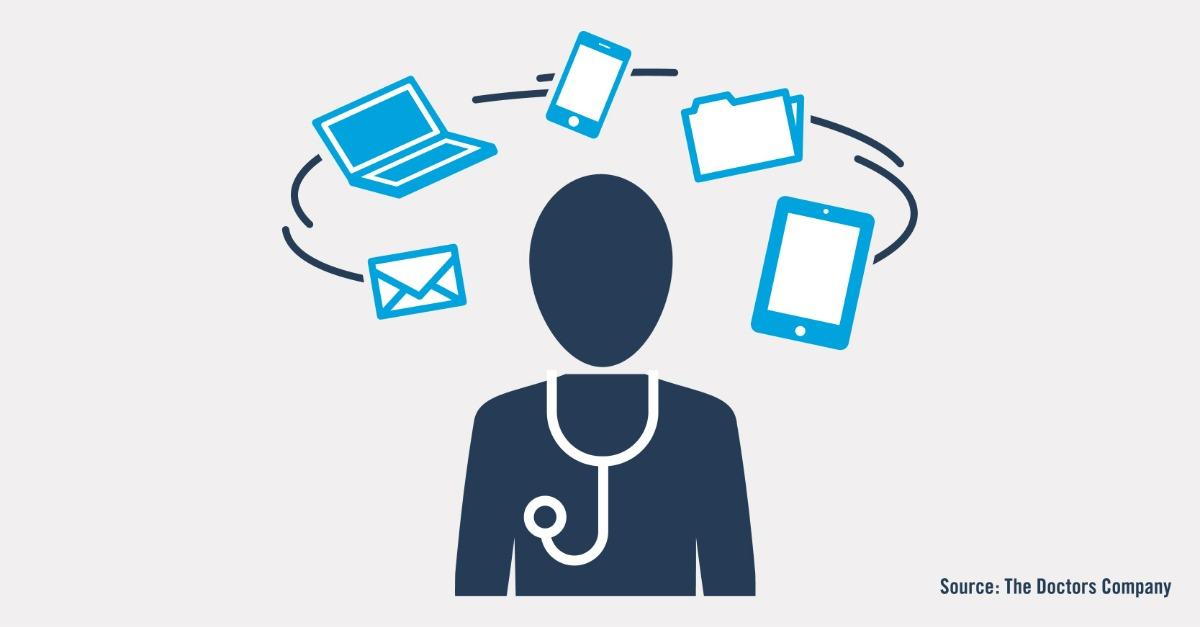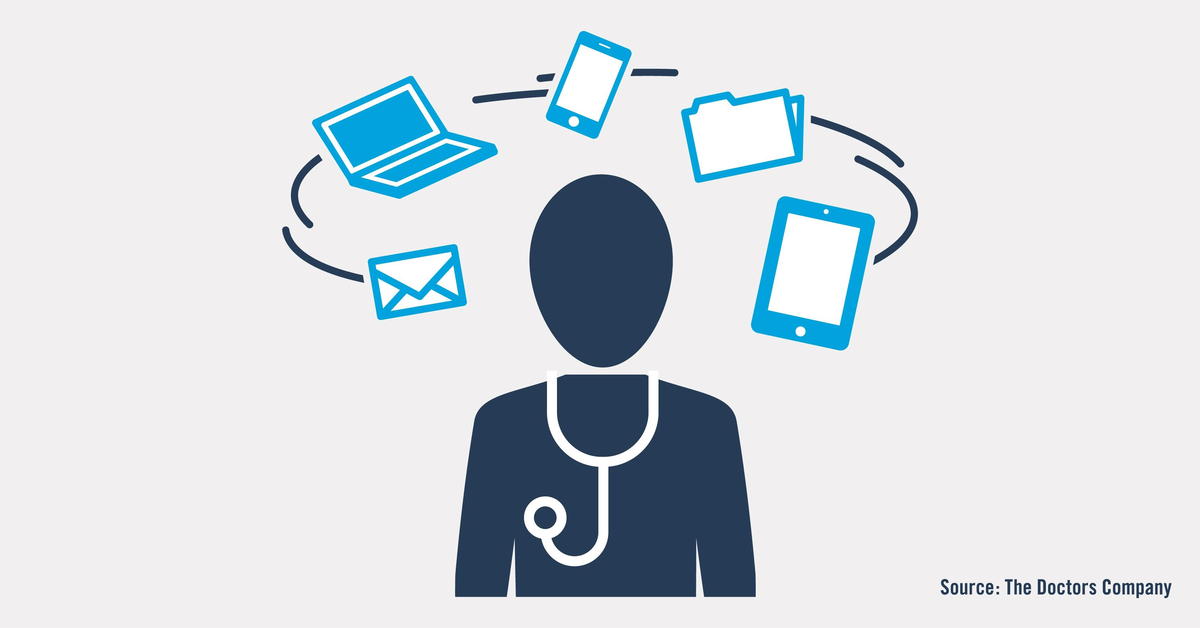
 Digital distraction in healthcare is emerging as a great threat to patient safety and doctor well-being.1 This phenomenon involves the habitual use of personal electronic devices by healthcare providers for nonclinical purposes during appointments and procedures.2 Some call it “distracted doctoring.” Matt Richtel, a journalist for the New York Times who won a Pulitzer Prize for his work on distracted driving, coined the term “distracted doctoring” in 2011.3 Like driving, attending to a patient’s complex care needs is a high-risk activity that requires undivided attention and presence in the moment to ensure the safety and protection of others.
Digital distraction in healthcare is emerging as a great threat to patient safety and doctor well-being.1 This phenomenon involves the habitual use of personal electronic devices by healthcare providers for nonclinical purposes during appointments and procedures.2 Some call it “distracted doctoring.” Matt Richtel, a journalist for the New York Times who won a Pulitzer Prize for his work on distracted driving, coined the term “distracted doctoring” in 2011.3 Like driving, attending to a patient’s complex care needs is a high-risk activity that requires undivided attention and presence in the moment to ensure the safety and protection of others.
But the threat might more aptly be called “distracted practice,” as it impacts all healthcare workers and staff. While distraction is particularly concerning in the operating room, emergency room, and critical care areas, it can impact all healthcare settings—including the office practice. Personal electronic devices can create a digital distraction so engaging that it consumes awareness, potentially preventing healthcare providers from focusing on the primary task at hand—caring for and interacting with patients. And the consequences can be devastating.
Our Devices Are Addictive
In today’s electronic culture, it has become unthinkable to be without personal electronic devices. Growing evidence shows that our personal electronic devices and social media are addictive.4 The reason is dopamine. Our dopamine systems are stimulated by the unpredictable, small, incomplete bursts of information with visual or auditory cues. For example, we are never quite sure when we will receive a text message and from whom. We may keep checking to see who liked our recent Facebook post. And when our devices ding or vibrate, we know our reward is coming. Yet as when gambling or playing the lottery, the anticipation of the reward is (usually) better than the reward itself. This results in more and more of what some call “seeking” and “wanting” behaviors. Then instant gratification encourages dopamine looping, and it becomes harder and harder to stop the cycle.
Distraction can also be both a symptom of and a contributor to healthcare provider stress and burnout. As a symptom of burnout, digital distraction is a way to escape a stressful environment. As a contributor to burnout, digital distraction impedes human interaction because of the sheer volume of data demanding our attention.
Medical Malpractice Implications
For most healthcare providers, distractions and interruptions are considered part of the job; it is the nature of their work. If we consider healthcare distraction on a continuum, on one end are distractions related to clinical care (e.g., answering team member questions or responding to surgical equipment alarms). On the other end of the continuum are distractions unrelated to clinical care (e.g., making personal phone calls, sending personal text messages, checking social media sites, playing games, or searching airline flights).
From a litigation perspective, the distinction between distractions related to clinical care and those unrelated to clinical care is important. In a medical malpractice claim where there is an allegation that an adverse event was caused by distracted practice, a distraction caused by a clinical-care-related activity may be found to be within the standard of care and is, therefore, often defensible. But where it can be shown that the distraction was caused by non-patient matters, the plaintiff’s attorney will certainly use that against the defendant. In these situations, the defendant’s medical care may not even enter the equation, because during eDiscovery the metadata (i.e., cell phone records, scouring findings from hard drives) serves as the “expert witness.” Even if the defendant’s clinical care was within the standard, the fact that there are cell phone records indicating that the healthcare provider was surfing the Internet or checking personal e-mail may imply distraction and could potentially supersede all other evidence.
Preventing Distractions
Complex problems require a multifaceted approach. Organizations, teams, and individuals all should take responsibility and ownership for reducing the risks associated with digital distraction. The following are risk management strategies to prevent distractions and enhance patient safety.
Organizations
- Create awareness
- Recognize the extent of the problem and risks.
- Model appropriate personal electronic device use behaviors.
- Tier communication to batch non-emergent messages.
- Refrain from sending texts on non-urgent matters.
- Do not expect immediate responses for non-urgent matters.
- Educate system-wide
- Train all healthcare providers and staff at orientation and conduct annual refreshers on safety concerns, legal risks of using personal electronic devices when providing care, device-user etiquette, and the addictive potential of technology.
- Use simulation-based learning where distractions and interruptions are introduced during high-risk procedures.
- Use case studies of real-life examples where distraction was alleged to play a role in an adverse event.
- Deploy technology solutions
- Manage facility-issued devices.
- Create technology-free zones.
- Limit Internet access to work-related sites only—EMR, labs, images, pharmacy formulary, state Rx databases, and decision support/cognitive aids.
- Enforce
- Monitor compliance with system-wide protocols and guidelines.
- Clearly define how personal electronic devices are used in patient care areas.
Teams
- Reinforce situational awareness and mindful practices with your team or department through:
- Unit-specific protocols: “Sterile Cockpit” and “Below 10,000 Feet” protocols limiting or eliminating nonessential activities during critical phases of procedures and high-risk activities.
- Empowering every team member to speak up when they have a safety concern. For example, encourage team members to speak up when they notice another member is so focused on a personal electronic device that he or she has lost situational awareness about the patient’s clinical condition.
- Applying TeamSTEPPS® principles: leadership, situational awareness, mutual support, and communication.
- Create a process where employees can be reached via a call to a central location, with messages relayed to the employee by a staff member. This alleviates employees’ desire to have their personal electronic devices nearby in case of a family emergency.
- Monitor compliance as part of the team’s quality measures.
Individuals
- Take personal responsibility—ignore distractions, especially during high-risk procedures, and make sure to speak up, set an example, and remain vigilant.
- Practice situational awareness:
- Pay attention to what is happening in the present moment.
- Increase attention, focus, and concentration.
- Leave your device behind.
New CME Courses Address Distracted Practice Concerns
Two new CME courses from The Doctors Company, How Healthcare Leaders Can Reduce Risks of Distracted Practice in Their Organization and The Risks of Distracted Practice in the Perioperative Area, address addiction to personal electronic devices and provide strategies that individuals and organizations can use to minimize the patient safety risks associated with distractions from these devices.
Find these courses and explore our extensive catalog of complimentary CME and CE activities at http://www.thedoctors.com/patient-safety/education-and-cme/ondemand/.
References:
1.Distracted Doctoring: Returning to Patient-Centered Care in the Digital Age
https://www.amazon.com/Distracted-Doctoring-Returning-Patient-Centered-Digital/dp/331948706X
2.Treat, Don’t Tweet: The Dangerous Rise of Social Media in the Operating Room
https://psmag.com/social-justice/treat-dont-tweet-dangerous-rise-social-media-operating-room-79061
3.As Doctors Use More Devices, Potential for Distraction Grows
http://www.nytimes.com/2011/12/15/health/as-doctors-use-more-devices-potential-for-distraction-grows.html
4.Why We’re All Addicted to Texts, Twitter and Google
https://www.psychologytoday.com/blog/brain-wise/201209/why-were-all-addicted-texts-twitter-and-google
Additional Resources
5.Daily Time Spent on Social Networking by Internet Users Worldwide from 2012 to 2017 (in minutes)
https://www.statista.com/statistics/433871/daily-social-media-usage-worldwide/
6.Anesthesia and the Law, Preferred Physicians Medical Risk Management Newsletter (August 2014, Issue 39)
https://www.ppmrrg.com/risk-management/anesthesia-law/archive
7.Interruptions and Distractions in Health Care: Improved Safety with Mindfulness
https://psnet.ahrq.gov/perspectives/perspective/152/interruptions-and-distractions-in-health-care-improved-safety-with-mindfulness
8.Distracted Doctoring: The Role of Personal Electronic Devices in the Operating Room
https://www.sciencedirect.com/science/article/pii/S2405603017300365
Contributed by The Doctors Company. For more patient safety articles and practice tips, visit www.thedoctors.com/patientsafety.
The guidelines suggested here are not rules, do not constitute legal advice, and do not ensure a successful outcome. The ultimate decision regarding the appropriateness of any treatment must be made by each healthcare provider in light of all circumstances prevailing in the individual situation and in accordance with the laws of the jurisdiction in which the care is rendered.
